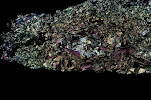I just read and took notes on the next section of the paper I’ve been “actively reading” for my 1000 words a day from the geologic literature, and am pleased to note that while I read well over 1000 (bringing yesterday’s and today’s combined total over 2000 words), it took just under 35 minutes to do so. I don’t know if this is because I’m becoming more comfortable with the process of active reading and typing up notes on each paragraph I read as I read them, or if these notes are less extensive than those for the earlier section, but I’m hopping it is just a matter of practice making me more efficient. I am willing to make 30 minutes a day, every day for this goal, but the over an hour I spent the first time I tried this technique might be asking a bit much.
I don’t know if anyone is actually reading the notes I’ve been posting, but I shall continue to post them till I reach the end of this article. If it should happen that someone tells me that the notes are interesting and/or helpful, I could easily be talked into continuing to post them for future articles I read, too. However, I suspect that for most people who are looking for interesting blogs to read one article summarized one paragraph at a time will be plenty. Feel free to let me know if I’m mistaken on that point.
Today’s notes are from the section on microstructural analysis:
Paragraph 53 introduces the locations from which the samples were collected for microstructural analysis and gives the goals for this portion of the study (understand mechanisms and relative timing of juxtaposition of the units)
Paragraph 54 mentions which samples were chosen for electron back scatter diffraction, gives details of what was found and compares and contrasts the results from the leucosome and mesosome layers of the sample. They go on to offer a tentative (since there weren’t enough samples analyzed to be confidant) interpretation (possible late shear zone affected the structurally deepest exposed rocks)
Paragraph 55 names a sample chosen for EBSD, reiterates that it is from the Skagit Gneiss), gives published U/Pb zircon age for this sample (which is younger than for other Skagit Gneiss samples), and describes the areas in this sample for which they made EBSD maps.
Paragraph 56 lists the results of the EBSD analysis for this sample (including strong crystallographic preferred orientation, prism slip for quartz (both regions of sample), sub grain rotation and recrystallisation (in shear zone), different grain sizes in different regions.
Paragraph 57 describes an effect (some qtz not deformed adjacent to larg plg grain) which only shows up in EBSD map, not via traditional optical methods. It also points out that such variety in qtz textures could indicate qtz deformed at all T and may have preserved evidence for more than one condition.
Paragraph 58 gives EBSD results for a new sample, from a new location.
Paragraph 59 mentions that the above sample has overprinting which doesn’t show up in higher parts of Ruby Mt. (instead the higher parts preserve high-T fabric with not much qtz recrystalization).
Paragraph 60 discusses textures in the structurally highest regions of Skagit Gneiss, and interpret them to indicate that the shear zone is a high-T feature.
Paragraph 61 more EBSD results this time for another couple of samples, comparing and contrasting them with each other, and with the other samples in the area. Interprets the results to indicate that the quartzite may have taken up much of the low-T deformation in this area
Paragraph 62 gives the EBSD results for samples from the RLFZ because they feel that understanding deformation in the fault zone will help interpretation of the role of the fault in burial and exhumation. They point out the similarities between these samples and the above.
Here ends the microstructural analysis section. I found it slightly hard to follow in terms of understanding which samples/areas were being discussed when, but that was because I hadn’t made notes about the sample names/locations in my pre-reading familiarization session. Nonetheless, I think that sub headings might have helped.
The next section will cover the 40Ar/39Ar results.
Happy Holidays!
5 days ago




No comments:
Post a Comment